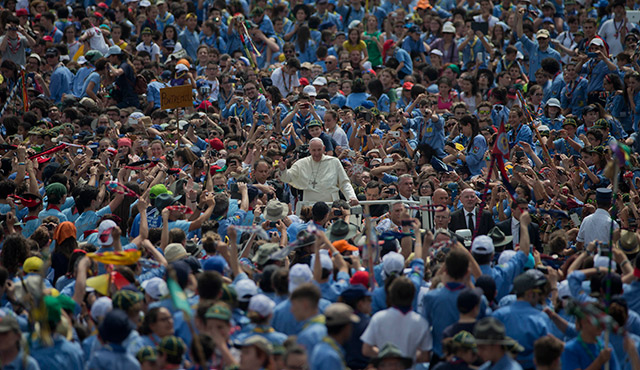With more than 1.2 billion followers worldwide, it’s hard to imagine that the Roman Catholic Church was ever considered small.
But early Christianity tells the story of a burgeoning movement that not only survived decades of persecution but rose under an unraveling Roman Empire and evolved into a religion that is practiced around the world today.
“It’s just so amazing that all the things that were set in motion centuries ago and all of the stuff going on in the Roman Empire – everything had to be fulfilled,” says Holy Family Cathedral’s parochial vicar, Fr. Troy Schneider, who studied early church history at the Catholic University of Leuven. “It was ripe for all people to recognize this incredible gospel that was new to everybody.”
After the death of Christ, many thought that his return would be immediate and apocalypse would soon follow.
However, different parts of the New Testament interpreted it “as a story of the expansion and progress of the faith, with the expectation that that expansion would continue for a long time, with Christ returning only at its culmination far in the future,” according to William C. Placher and Derek R. Nelson’s “A History of Christian Theology, Second Edition: An Introduction.”
The formation of the church starts with Jesus designating Peter as the head of the apostles and the church. In the New Testament, it’s says that Christ appeared to Peter before any other apostle when he resurrected. There are also references to Christ calling Peter the rock of the church and giving him the keys to the kingdom.
“These are thought to be church-founding incidents,” says Fr. Robert Spitzer, president of the Magis Center of Reason and Faith in Garden Grove.
The Council of Jerusalem in 50 A.D. further reinforces Peter’s leadership role when he weighs in on whether gentiles are required to adhere to Jewish practices.
“It’s Peter who makes the decision, based on the vision that he is formally given,” Spitzer says. “It has a formal ring to it.”
But the new church was facing persecution. Its beliefs did not sit well with Emperor Nero, who not only ordered Christians to be killed but also made it entertainment. People were fed to animals, set on fire and nailed to crosses.
“We talk a lot about the church being founded on the blood of martyrs,” Schneider says. “But no matter how much they beat them up, (Christianity) kept spreading like wildfire, mostly because of the Roman roads. It was the Internet of the first century.”
The ability to travel on good roads allowed Christianity to thrive in places such as Corinth.
“Corinth is a trade harbor and those types of cities didn’t have the highest of morals,” Schneider says. “But the city of Corinth flourished with Christianity. Everybody was welcomed. There was no caste system like with the Roman Empire. Suddenly, the lowliest, the worst type of ethical and moral people were invited to change their lives and have a clean slate.”
Staying unified also played a role in formalizing the church. The first use of the term “Catholic Church” was in St. Ignatius of Antioch’s letter to the Smyrnaeans in 110 A.D.
“He referred to the conglomeration of all the Christian churches and all that follow Christ as the one universal church,” Schneider says. “He was really motivating them to stay united as one and not fall into different sects, which were happening at the time.”
The church began to grow exponentially when Christians began educating and providing welfare and public health to anyone who wanted it, including slaves.
“What was happening was that Christianity was getting a huge number of people in the slave classes and lower classes of Rome,” Spitzer says.
By 313 A.D., the Edict of Milan legalized Christianity, and by 380 A.D. Theodosius I made the Catholic faith the official religion of the Roman Empire, rejecting other factions.
When the Roman Empire crumbled a century later due after years of government instability, the church stepped in to feed, care for and protect the Roman population.
“When the Roman Empire fell, all that was left with any kind of structure was the church,” Schneider says.
The church eventually spread its missionary work to Europe and increased in power and authority throughout Western civilization.
Schneider says the church’s ability to survive and thrive in its early days is a testament to the strength of Christ’s teachings.
“The relevance of the gospel 2,000 years later has proven that what the church teaches – the message of Jesus – is as true today, and it’s a real good message for everyone to hear,” Schneider says. “Despite ourselves, the church is still here. It’s divinely instituted. There was a lot of turmoil but the church still stands.”

